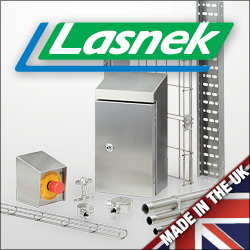
Posted to News on 15th Feb 2016, 11:35
Smart sensors reduce PLC processing overhead and boost uptime
Sick's engineers have been developing new 'intelligent' sensors that undertake some of the processing that would normally take place within the PLC or PAC. This article explains the advantages 'smart sensors' offer machine builders, system integrators and end users.

Product innovators at Sick AG's Waldkirch headquarters in Germany believe they are the first to make sensors 'smart' by moving intelligent functions from the PLC or PAC to the sensors themselves. Development teams, already familiar with the latest demands from customers across the world to improve automated processes, are now starting to find opportunities to add smart variants across product ranges.
As chip technology has enabled more functionality to be packed into ever smaller devices, Sick has identified opportunities to integrate advanced automation capability into the sensors themselves. Smart sensors offer a step change in sensing performance, with photoelectric, magnetic and proximity sensors being equipped with powerful on-board processing capability to optimise machines and automation on high-speed production lines. By taking processing load away from central control systems, smart sensors deliver additional flexibility, reliability and throughput in automated systems, as well as reducing costs.
David Hannaby, Product Manager for Presence Detection at Sick UK, comments: "By building advanced intelligence into standard sensors, Sick has made sensors 'smart and achieved a world first. Smart sensors perform complex process functions locally, moving them away from the PLC to the sensor itself.
"Real time events can be locally processed, without waiting for the raw data to be uploaded to the central PLC program, processed and information extracted before action. Speed restrictions due to heavily-loaded networks are avoided and demands on the central computing functions are massively reduced.
"The information provided by sensors about pressure, temperature, flow, end position, speed, output state and so on, all help to make automated factory systems faster and more effective. Sometimes a standard sensor with IO-Link will be all that is needed. But now, a range of advanced function blocks can be built into sensors of all types to provide a powerful new set of tools for the engineer."
Smart sensor functions

With these functions, logical loops are moved away from the PLC to the sensor, so real-time events can be processed locally.
Hannaby continues: "Recognising the potential for smart sensors begins with understanding the functions opened up by IO-Link. With IO-Link, the simple sensor has quickly evolved to deliver highly-useful capabilities that have helped power factory automation forward.
"The first is easier device replacement: identifying when a sensor is failing, for example, finding and replacing it, then manually configuring the replacement frequently results in hours of costly downtime. With IO-Link, a sensor can display its exact location on an HMI, allowing speedy location and replacement. The automation system will recognise a new device and automatically download the application-specific, correct settings, without requiring specially-trained personnel."
IO-Link sensors also enable parameter settings to be adjusted remotely from the central PLC or HMI. As a result, greater product variation has been facilitated and shorter runs and smaller batches made more economically viable. By reducing downtime and avoiding setting error risk, maximum throughput is achieved and costs minimised.
Smart preventative maintenance
Using IO-Link-enabled sensors can transform the cost of condition monitoring and preventative maintenance on a busy production line by providing routine or interrogated diagnostic data. Production management can assess and tailor plant-wide maintenance schedules using real-time data updates from areas under most stress. Critical pinch points can be identified and requirements balanced against plant segments where necessary, but less urgent work can be deferred, all backed by full data.
Centralised control also enables centralised inventory and documentation of all sensors, settings and maintenance work. This capability facilitates detailed record keeping for parts lifetime and replacement costs monitoring, for process traceability and accurate production history recording.
Each of these functions can be monitored and controlled through the sensor visualisation software, by connecting the sensor to a PC to display sensor-specific information.
Building 'smart' IO-Link sensors
With the power of IO-Link also comes the opportunity to add intelligent, remote functions into the sensors themselves and therefore overcome control system and network limitations. A wide selection of IO-link gateway cards is available from the major PLC manufacturers to integrate smart sensors into automation networks. By introducing enhanced functionality into a sensor, the load on a PLC is significantly reduced.
With this reduction in computing load at the PLC, management of fast processes is accelerated and data processing capability limitations reduced, thereby enhancing process speeds with higher productivity and efficiency.
Examples of smart sensors

A smart sensor can use time-based position measurement to calculate product length, or distance between objects on a high speed conveyor, to ensure they are the right size or in precisely the right position - for example, for picking or dimensions measurements of packages.

Even time tracking can be incorporated thanks to the accuracy of in-sensor time evaluation that assigns a time value that can accurately locate a product further along the product line despite signal delays in network communication with the central processor. Also precise real-time location provides rapid, localised distance sensing for measuring product lengths and spacing. As well as improving productivity and quality, real-time location is useful when accurate product slippage monitoring is required for a moving belt.
David Hannaby adds: "Smart sensors take processing load away from central control systems and deliver huge potential in additional flexibility, reliability and throughput for automated production tasks, as well as reducing costs and quality issues. The customer response to date has been excellent, and Sick is already extending smart functionality into a wider range of sensors, and introducing more functions."
Fieldbus integration

Hannaby concludes: "The contribution from smart sensors to modern automated manufacturing will be realised more and more widely. Sick is introducing smart variants to its ranges at a rapid rate, realising the potential not only to simply detect any object, often at high speeds, but also to eliminate production headaches."
Follow the link for more information about the Sick Smart Sensor programme.
Want the latest machine building news straight to your inbox? Become a MachineBuilding member for free today >>



















